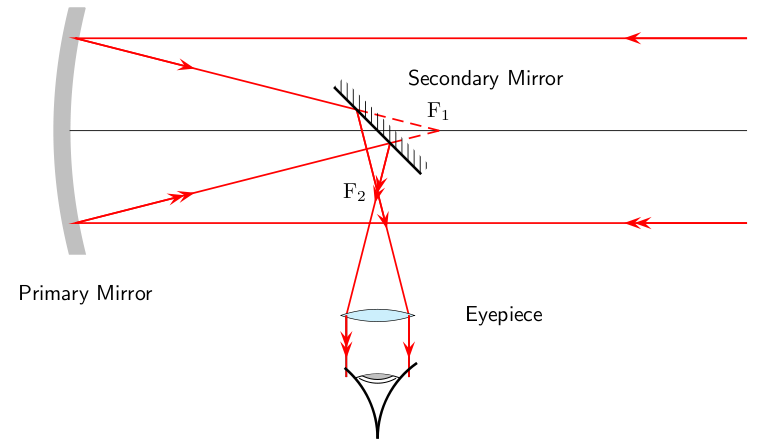| << Chapter < Page | Chapter >> Page > |
We have seen how a simple lens can be used to correct eyesight. Lenses and mirrors are also combined to magnify (or make bigger) objects that are far away.
Telescopes use combinations of lenses to gather and focus light. Telescopes collect light from objects that are large but far away, like planets and galaxies. For this reason, telescopes are the tools of astronomers. Astronomy is the study of objects outside the Earth, like stars, planets, galaxies, comets, and asteroids.
Usually the object viewed with a telescope is very far away. Objects closer to Earth, such as the moon, appear larger, and with a powerful enough telescope, we are able to see craters on the Moon's surface. Objects which are much further, such as stars, appear as points of light. Even with the most powerful telescopes currently built, we are unable to see details on the surfaces of stars.
There are many kinds of telescopes, but we will look at two basic types: reflecting and refracting.
A refracting telescope like the one pictured in [link] uses two convex lenses to enlarge an image. The refracting telescope has a large primary lens with a long focal length to gather a lot of light. The lenses of a refracting telescope share a focal point. This ensures that parallel rays entering the telescope are again parallel when they reach your eye.

Some telescopes use mirrors as well as lenses and are called reflecting telescopes. Specifically, a reflecting telescope uses a convex lens and two mirrors to make an object appear larger. ( [link] .)
Light is collected by the primary mirror, which is large and concave. Parallel rays traveling toward this mirror are reflected and focused to a point. The secondary plane mirror is placed within the focal length of the primary mirror. This changes the direction of the light. A final eyepiece lens diverges the rays so that they are parallel when they reach your eye.

The Southern African Large Telescope (SALT) is the largest single optical telescope in the southern hemisphere, with a hexagonal mirror array 11 metres across. SALT is located in Sutherland in the Northern Cape. SALT is able to record images of distant stars, galaxies and quasars a billion times too faint to be seen with the unaided eye. This is equivalent to a person being able to see a candle flame on the moon.
SALT was completed in 2005 and is a truly international initiative, because the money to build it came from South Africa, the United States, Germany, Poland, the United Kingdom and New Zealand.
SALT is part of SAAO. Write your investigation as a short 5-page report. Include images of the instrumentation used.
We have seen how lenses and mirrors are combined to magnify objects that are far away using a telescope. Lenses can also be used to make very small objects appear bigger.

Notification Switch
Would you like to follow the 'Siyavula textbooks: grade 11 physical science' conversation and receive update notifications?